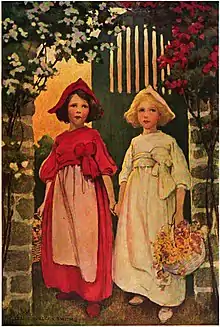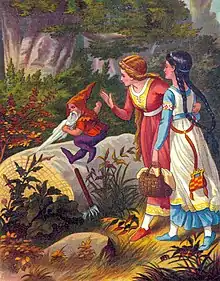Snow-White and Rose-Red
"Snow-White and Rose-Red" (German: Schneeweißchen und Rosenrot) is a German fairy tale. The best-known version is the one collected by the Brothers Grimm (KHM 161).[1] An older, somewhat shorter version, "The Ungrateful Dwarf", was written by Caroline Stahl (1776–1837). Indeed, that appears to be the oldest variant; no previous oral version is known, although several have been collected since its publication in 1818.[2] Oral versions are very limited regionally.[3] The tale is of Aarne-Thompson type 426 ("The Two Girls, the Bear, and the Dwarf").[1]
| Snow-White and Rose-Red | |
|---|---|
 Snow-White and Rose-Red by Jessie Willcox Smith, 1911 | |
| Folk tale | |
| Name | Snow-White and Rose-Red |
| Aarne–Thompson grouping | ATU 426 (The Two Girls, the Bear and the Dwarf) |
| Region | Germany |
| Published in | Kinder- und Hausmärchen, by the Brothers Grimm |
Despite the presence of one dwarf, this story is not related to the Brothers Grimm fairy tale "Snow White" that provided the basis for the 1937 Walt Disney animated film Snow White and the Seven Dwarfs. The modern German name of that heroine is Schneewittchen rather than Schneeweißchen. This story has little in common but the similar name of its fair-skinned girl.
Plot
Snow-White and Rose-Red are two little girls living with their mother, a poor widow, in a small cottage by the woods. Snow-White is quiet and shy and prefers to spend her time indoors, doing housework and reading. Rose-Red is outspoken, lively and cheerful, and prefers to be outside. They are both very good girls who love each other and their mother dearly, and their mother is very fond of them as well.
One winter night, there is a knock at the door. Rose-Red opens the door to find a bear. At first, she is terrified, but the bear tells her not to be afraid. "I'm half frozen and I merely want to warm up a little at your place," he says. They let the bear in, and he lies down in front of the fire. Snow-White and Rose-Red beat the snow off the bear, and they quickly become quite friendly with him. They play with the bear and roll him around playfully. They let the bear spend the night in front of the fire. In the morning, he leaves trotting out into the woods. The bear comes back every night for the rest of that winter and the family grows used to him.

When summer comes, the bear tells them that he must go away for a while to guard his treasure from a wicked dwarf. During the summer, when the girls are walking through the forest, they find a dwarf whose beard is stuck in a tree. The girls rescue him by cutting his beard free, but the dwarf is ungrateful and yells at them for cutting his beautiful beard. The girls encounter the dwarf several times that summer and rescue him from some peril each time, for which he is ungrateful.
Then one day, they meet the dwarf once again. This time, he is terrified because the bear is about to kill him. The dwarf pleads with the bear and begs it to eat the girls. Instead, the bear pays no heed to his plea and kills the dwarf with one swipe of his paw. Instantly, the bear turns into a prince. The dwarf had previously put a spell on the prince by stealing his precious stones and turning him into a bear. The curse is broken with the death of the dwarf. Snow-White marries the prince and Rose-Red marries the prince's brother.
Analysis
Tale type
The tale is classified in the international Aarne-Thompson-Uther Index as tale type ATU 426, "The Two Girls, the Bear, and the Dwarf": a pair of sisters welcome a bear into their house; the next summer, the girls rescue an ungrateful dwarf three times; at the end of the tale, the bear defeats the dwarf (who cursed him in the first place) and becomes a human prince.[4][5][6]
According to scholars Johannes Bolte, Jiri Polívka, Stith Thompson and Hans-Jörg Uther, the tale, in the Grimm's compilation, originated from a story written by author Karoline Stahl and published in 1818.[7][8][9]
Germanic languages
German folklorist Hans-Jörg Uther, in the Folktale Catalogue of the German-speaking Area, classifies the tale as type ATU 426, Schneeweißchen und Rosenrot ("Snow-White and Rose-Red"), which is sparsely attested in Germanophone areas.[10][11]
According to Frisian scholar Jurjen van der Kooi, in the Catalogue of Frisian Folktales, the tale type is also attested in Friesland, but the heroines are named Blauwoogje ("Blue-Eyes") and Bruin-oogje ("Brown-Eyes").[12] In addition, Dutch scholar Theo Meder published a Dutch tale titled Rozerood en Lelieblank ("Rose-Red and Lily-White"), from a teller from Driebergen, Utrecht, who sent it in 1892 to linguist Gerrit Jacob Boekenoogen.[13][14]
Johannes Bolte and Jiří Polívka cited a tale titled Rozenroodje, collected by J. F. Vincx from Hageland (Flanders).[15]
Slavic languages
The tale type is also attested in the East Slavic Folktale Classification (Russian: СУС, romanized: SUS), indexed as type SUS 426, "Две девушки, медведь (волк) и карлик" ("Two Girls, the Bear/Wolf and the Dwarf"), but only in Russia and Ukraine.[16]
Philologist and folklorist Julian Krzyżanowski, establisher of the Polish Folktale Catalogue according to the international index, located a single Polish variant of type 426, Narzeczony niedźwiedź ("The Bear Groom"). However, Krzyżanowski indicated that the tale was a literary reworking that excised the dwarf and introduced other characters.[17]
Other areas
According to the Latvian Folktale Catalogue, a similar story is found in Latvia, indexed as tale type 426, Lācis — princis ("Bear Prince"): two girls shelter a bear and rescue a dwarf; the bear defeats the dwarf and regains human form.[18]
French scholars Paul Delarue and Marie-Louise Thèneze, establishers of the French folktale catalogue, reported only two variants in France of tale type ATU 426, Les deux fillettes, l'ours et le nain ("The Two Little Girls, the Bear and the Dwarf"), which they considered to be retellings of the Grimm's story.[19]
Other versions
- "Schneeweißchen und Rosenrot" by the Brothers Grimm (German language)
- "Snow-White and Rose-Red"; May Sellar, transl., Andrew Lang, ed., The Blue Fairy Book, 1889
- Snow-White and Rose-Red and the Big Black Bear, by Clifton Johnson (1913)[20]
- "Rose White and Rose Red", storybook and cassette in Fabbri's Once Upon a Time series (audio)
- "Snow-White and Rose-Red"; Margaret Hunt, transl., Grimm's Household Tales, Vol. 2, No. 161
- "Snow-White and Rose-Red" by Edith Wyatt – short story
- Snow White and Rose Red by Patricia C. Wrede, in the Fairy Tale Series created by Terri Windling – 1989 fantasy novel based on the tale and set in medieval England
- The Shadow of the Bear by Regina Doman – 1997 novel based on the tale and set in contemporary New York City.
- Tender Morsels by Margo Lanagan – 2008 fantasy novel based on the tale
- Snow & Rose by Emily Winfield Martin, Random House, October 10, 2017
Gallery
 Snow-white and Rose-red, by Alexander Zick
Snow-white and Rose-red, by Alexander Zick Illustration by Alexander Zick
Illustration by Alexander Zick Illustration by Alexander Zick
Illustration by Alexander Zick
See also
References
- Ashliman, D. L. (2020). "Grimm Brothers' Children's and Household Tales (Grimms' Fairy Tales)". University of Pittsburgh.
- Jack Zipes, The Great Fairy Tale Tradition: From Straparola and Basile to the Brothers Grimm, p. 772, ISBN 0-393-97636-X
- Stith Thompson, The Folktale, p. 100, University of California Press, Berkeley Los Angeles London, 1977.
- Aarne, Antti; Thompson, Stith. The types of the folktale: a classification and bibliography. Folklore Fellows Communications FFC no. 184. Helsinki: Academia Scientiarum Fennica, 1961. p. 145.
- Ashliman, D. L. A Guide to Folktales in the English Language: Based on the Aarne-Thompson Classification System. Bibliographies and Indexes in World Literature, vol. 11. Westport, Connecticut: Greenwood Press, 1987. p. 91. ISBN 0-313-25961-5.
- Uther, Hans-Jörg (2004). The Types of International Folktales: A Classification and Bibliography, Based on the System of Antti Aarne and Stith Thompson. Suomalainen Tiedeakatemia, Academia Scientiarum Fennica. p. 256. ISBN 978-951-41-0963-8.
- Bolte, Johannes; Polívka, Jiri. Anmerkungen zu den Kinder- u. hausmärchen der brüder Grimm. Dritter Band (NR. 121–225). Germany, Leipzig: Dieterich'sche Verlagsbuchhandlung, 1918. p. 259.
- Thompson, Stith (1977). The Folktale. University of California Press. p. 121. ISBN 0-520-03537-2.
- Uther, Hans-Jörg (2004). The Types of International Folktales: A Classification and Bibliography, Based on the System of Antti Aarne and Stith Thompson. Suomalainen Tiedeakatemia, Academia Scientiarum Fennica. p. 256. ISBN 978-951-41-0963-8.
- Uther, Hans-Jörg. Deutscher Märchenkatalog. Ein Typenverzeichnis. Waxmann Verlag, 2015. p. 104. ISBN 9783830983323.
- Neumann, Siegfried (1974). Eine Mecklenburgische Märchenfrau: Bertha Peters erzählt - Märchen, Schwänke und Geschichten (in German). Berlin, Boston: De Gruyter. pp. 84-89 (text for tale nr. 14), 205 (classification). doi:10.1515/9783112563168.
- Kooi, Jurjen van der (1984). Volksverhalen in Friesland: lectuur en mondelinge overlevering: een typencatalogus (in Dutch). Stichting Ffyrug/Stichting Sasland. p. 326.
- Meder, Theo (2000). De Magische Vlucht: Nederlandse volksverhalen (in Dutch). Amsterdam: Uitgeverij Bert Bakker. pp. 66-68 (text), 260 (source for tale nr. 9).
- Meder, Theo (2008). The Flying Dutchman and Other Folktales from the Netherlands. Westport, Connecticut; London: Libraries Unlimited. pp. 38–39.
- Bolte, Johannes; Polívka, Jiri. Anmerkungen zu den Kinder- u. hausmärchen der brüder Grimm. Dritter Band (NR. 121–225). Germany, Leipzig: Dieterich'sche Verlagsbuchhandlung, 1918. p. 259.
- Barag, Lev. "Сравнительный указатель сюжетов. Восточнославянская сказка". Leningrad: НАУКА, 1979. p. 132.
- Krzyżanowski, Julian. Polska bajka ludowa w ukìadzie systematycznym: Wa̜tki 1-999. Wydawn. Polskiej Akademii Nauk, 1962. p. 137.
- Arājs, Kārlis; Medne, A. Latviešu pasaku tipu rādītājs. Zinātne, 1977. p. 67.
- Delarue, Paul. Le conte populaire français: catalogue raisonné des versions de France et des pays de langue française d'outre-mer: Canada, Louisiane, îlots français des États-Unis, Antilles françaises, Haïti, Ile Maurice, La Réunion. Érasme, 1957. p. 110.
- Johnson, Clifton. A book of fairy-tale bears; selections from favorite folk-lore stories. Boston, New York: Houghton Mifflin Company. 1913. pp. 31–47.
- Grimm, Jacob and William, edited and translated by Stanley Appelbaum, Selected Folktales/Ausgewählte Märchen : A Dual-Language Book Dover Publications Inc. Mineola, New York. ISBN 0-486-42474-X
- Andrew Lang's "Blue Fairy Tale Book"
Further reading
- Hameršak, Marijana (17 June 2011). "A Never Ending Story? Permutations of 'Snow White and Rose Red' Narrative and Its Research across Time and Space". Narodna Umjetnost. 48 (1): 147–160.
- Rölleke, Heinz (1986). "Schneeweißchen und Rosenroth. KHM 161 in der Grimmschen 'Urfassung'. Zwei bislang ungedruckte Briefe Wilhelm Hauffs an Grimm und ein Nachtrag zum Fest der Unterirdischen, einem frühen Zeugnis norwegischer Volksliteratur". Fabula (in German). 27: 265–287. doi:10.1515/fabl.1986.27.1.265.